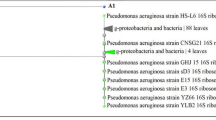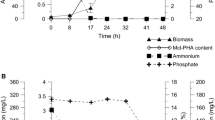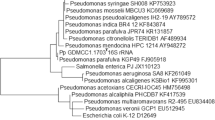Abstract
Toxic polycyclic aromatic hydrocarbons (PAHs) are often released into the environment during the combustion and processing of fossil fuels and are capable of causing significant pollution to people and the environment. One of the representative substances of PAHs is phenanthrene, which is often studied as a model compound for PAHs treatment. In this study, we compared the results of transcriptome analysis of Pseudomonas stutzeri LH-42 in two different culture conditions under phenanthrene-induced culture (test group) and glucose-induced culture (control group), and analysed the key enzymatic mechanisms of Pseudomonas stutzeri LH-42 in the biodegradation of phenanthrene. In our experiments, the transcriptome results showed that a total of 380 genes were more than twofold differentially expressed in the test group, of which 187 genes were significantly up-regulated in expression under Phenanthrene induction. Among the 380 differentially expressed genes, 90 genes were involved in Phenanthrene biodegradation, mainly including genes involved in biometabolism, cellular chemotaxis, substrate transport, signal induction and other related processes. Based on the transcriptome sequence analysis of Pseudomonas stutzeri LH-42 at the time of phenanthrene induction, a total of 25 dioxygenase genes were identified, and the related genes were mainly concentrated in two relatively concentrated clusters of PAHs biodegradation genes. The transcriptome analysis resulted in a complete set of enzyme genes related to the phenanthrene biodegradation pathway. The analysis of key enzymes led to the inference of a possible phenanthrene biodegradation pathway: the salicylic acid degradation pathway. The results of this study provide a theoretical basis for in situ remediation of PAHs-contaminated environments using Pseudomonas stutzeri LH-42.











Similar content being viewed by others
Data Availability
Authors can confirm that all relevant data are included in the articleand/or its supplementary information files.
References
Chandra S, Singh D, Pathak J et al (2017) SNP discovery from next-generation transcriptome sequencing data and their validation using KASP assay in wheat (Triticum aestivum L.). Mol Breed 37:92. https://doi.org/10.1007/s11032-017-0696-7
Dandajeh HA, Talibi M, Ladommatos N, Hellier P (2019) Influence of combustion characteristics and fuel composition on exhaust PAHs in a compression ignition engine. Energies 12:2575. https://doi.org/10.3390/en12132575
Ghasemi Y, Rasoul-Amini S, Fotooh-Abadi E (2011) The biotransformation, biodegradation, and bioremediation of organic compounds by microalgae. J Phycol 47:969–980. https://doi.org/10.1111/j.1529-8817.2011.01051.x
Gupta S, Pathak B, Fulekar MH (2015) Molecular approaches for biodegradation of polycyclic aromatic hydrocarbon compounds: a review. Rev Environ Sci Biotechnol 14:241–269. https://doi.org/10.1007/s11157-014-9353-3
Ha J, Lee T, Kim MY et al (2017) Comprehensive transcriptome analysis of Lactuca indica, a traditional medicinal wild plant. Mol Breed 37:112. https://doi.org/10.1007/s11032-017-0711-z
Han KY, Kim KT, Joung JG et al (2018) SIDR: simultaneous isolation and parallel sequencing of genomic DNA and total RNA from single cells. Genome Res 28:75–87. https://doi.org/10.1101/gr.223263.117
Haritash AK, Kaushik CP (2009) Biodegradation aspects of polycyclic aromatic hydrocarbons (PAHs): a review. J Hazard Mater 169:1–15. https://doi.org/10.1016/j.jhazmat.2009.03.137
Hu T, Zhang J, Chen Y, Li Z, Xing X, Yuan Z et al (2017) Status, source and health risk assessment of polycyclic aromatic hydrocarbons (PAHs) in soil from the water-level-fluctuation zone of the Three Gorges Reservoir, China. J Geochem Explor 172:20–28. https://doi.org/10.1016/j.gexplo.2016.09.012
Huang Y, Wan J, Guo Y et al (2017) Transcriptome analysis of induced pluripotent stem cell (iPSC)-derived pancreatic β-like cell differentiation. Cell Transplant 26:1380–1391. https://doi.org/10.1177/0963689717720281
Huang C, Wang R, Zeng G et al (2018) Transcriptome analysis reveals novel insights into the response to Pb exposure in Phanerochaete chrysosporium. Chemosphere 194:657–665. https://doi.org/10.1016/j.chemosphere.2017.12.046
Inam E, Etuk I, Offiong NA et al (2018) Distribution and ecological risks of polycyclic aromatic hydrocarbons (PAHs) in sediments of different tropical water ecosystems in Niger Delta, Nigeria. Environ Earth Sci 77:216. https://doi.org/10.1007/s12665-018-7396-4
Isaac P, Sánchez LA, Bourguignon N et al (2013) Indigenous PAH-degrading bacteria from oil-polluted sediments in Caleta Cordova, Patagonia Argentina. Int Biodeterior Biodegrad 82:207–214. https://doi.org/10.1016/j.ibiod.2013.03.009
Janbandhu A, Fulekar MH (2011) Biodegradation of phenanthrene using adapted microbial consortium isolated from petrochemical contaminated environment. J Hazard Mater 187:333–340. https://doi.org/10.1016/j.jhazmat.2011.01.034
Lai KP, Li JW, Cheung A et al (2017) Transcriptome sequencing reveals prenatal PFOS exposure on liver disorders. Environ Pollut 223:416–425. https://doi.org/10.1016/j.envpol.2017.01.041
Lee BK, Dong TTT (2010) Effects of road characteristics on distribution and toxicity of polycyclic aromatic hydrocarbons in urban road dust of Ulsan, Korea. J Hazard Mater 175:540–550. https://doi.org/10.1016/j.jhazmat.2009.10.039
Liao Q, Li S, Siu SWI et al (2017) Novel Kunitz-like peptides discovered in the zoanthid Palythoa caribaeorum through transcriptome sequencing. J Proteome Res. https://doi.org/10.1021/acs.jproteome.7b00686
Lin W, Noel P, Borazanci EH et al (2020) Single-cell transcriptome analysis of tumor and stromal compartments of pancreatic ductal adenocarcinoma primary tumors and metastatic lesions. Genome Med. https://doi.org/10.1186/s13073-020-00776-9
Ma X, Liu Y, Liu Y et al (2018) Pan-cancer genome and transcriptome analyses of 1699 paediatric leukaemias and solid tumours. Nature. https://doi.org/10.1038/nature25795
Macchi M, Martinez M, Tauil RMN et al (2018) Insights into the genome and proteome of Sphingomonas paucimobilis strain 20006FA involved in the regulation of polycyclic aromatic hydrocarbon degradation. World J Microbiol Biotechnol 34:7. https://doi.org/10.1007/s11274-017-2391-6
Moser R, Stahl U (2001) Insights into the genetic diversity of initial dioxygenases from PAH-degrading bacteria. Appl Microbiol Biotechnol 55:609–618. https://doi.org/10.1007/s002530000489
Ohlendorf DH, Lipscomb JD, Weber PC (1988) Structure and assembly of protocatechuate 3,4-dioxygenase. Nature 336:403–405. https://doi.org/10.1038/nsb1203-980
Pacifico R, Davis RL (2016) Transcriptome sequencing implicates dorsal striatum-specific gene network, immune response and energy metabolism pathways in bipolar disorder. Mol Psychiatry. https://doi.org/10.1038/mp.2016.94
Pang F, Wang L, Jin Y et al (2017) Transcriptome analysis of, Paecilomyces hepiali, at different growth stages and culture additives to reveal putative genes in cordycepin biosynthesis. Genomics. https://doi.org/10.1016/j.ygeno.2017.09.008
Peng RH, Xiong AS, Xue Y et al (2010) Microbial biodegradation of polyaromatic hydrocarbons. FEMS Microbiol Rev 32:927–955. https://doi.org/10.1111/j.1574-6976.2008.00127.x
Rezek J, Wiesche CID, Mackova M et al (2008) The effect of ryegrass (Lolium perenne) on decrease of PAH content in long term contaminated soil. Chemosphere 70:1603–1608. https://doi.org/10.1016/j.chemosphere.2007.08.003
Rodrigues EM, Morais DK, Pylro VS et al (2017) Aliphatic hydrocarbon enhances phenanthrene degradation by autochthonous prokaryotic communities from a pristine seawater. Microb Ecol. https://doi.org/10.1007/s00248-017-1078-8
Schlipalius DI, Tuck AG, Jagadeesan R et al (2018) Variant linkage analysis using de novo transcriptome sequencing identifies a conserved phosphine resistance gene in insects. Genetics 209:300688. https://doi.org/10.1534/genetics.118.300688
Segura A, Hernández-Sánchez V, Marqués S et al (2017) Insights in the regulation of the degradation of PAHs in, Novosphingobium, sp. HR1a and utilization of this regulatory system as a tool for the detection of PAHs. Sci Total Environ 590–591:381–393. https://doi.org/10.1016/j.scitotenv.2017.02.180
Seguraa H-S, Veronica M, Silvia, et al (2017) Insights in the regulation of the degradation of PAHs in, Novosphingobium sp. HR1a and utilization of this regulatory system as a tool for the detection of PAHs. Sci Total Environ 590–591:381–393. https://doi.org/10.1016/j.scitotenv.2017.02.180
Silva MD, Esposito E, Moody JD et al (2004) Metabolism of aromatic hydrocarbons by the filamentous fungus Cyclothyrium sp. Chemosphere 57:943–952. https://doi.org/10.1016/j.chemosphere.2004.07.051
Simon MJ, Osslund TD, Saunders R et al (1993) Sequences of genes encoding naphthalene dioxygenase in Pseudomonas putida strains G7 and NCIB 9816-4. Gene 127:31–37. https://doi.org/10.1016/0378-1119(93)90613-8
Sucai Y, Yaling G, Yun S et al (2018) Enhanced anoxic biodegradation of polycyclic aromatic hydrocarbons (PAHs) in a highly contaminated aged soil using nitrate and soil microbes. Environ Earth Sci 77:432. https://doi.org/10.1007/s12665-018-7629-6
Venomics I, Gland V (2017) Transcriptome analysis of juvenile and adult mexican rattlesnakes Crotalus simus, C. tzabcan, and C. culminatus revealed miRNA-modulated ontogenetic shifts. J Proteome Res 16:3370–3390. https://doi.org/10.1021/acs.jproteome.7b00414
Wang Z, Gerstein M, Snyder M (2009a) RNA-Seq: a revolutionary tool for transcriptomics. Nat Rev Genet 10:57–63. https://doi.org/10.1038/nrg2484
Wang J, Muyzer G, Bodelier PLE et al (2009b) Diversity of iron oxidizers in wetland soils revealed by novel 16S rRNA primers targeting Gallionella-related bacteria. ISME J 3:715–725. https://doi.org/10.1038/ismej.2009.7
Wang S, Li X, Liu W (2012) Degradation of pyrene by immobilized microorganisms in saline-alkaline soil. J Environ Sci 24:1662–1669. https://doi.org/10.1016/S1001-0742(11)60963-7
Wang Z, Liu M, Yang Y (2015) Characterization and sources analysis of polycyclic aromatic hydrocarbons in surface sediments in the Yangtze River Estuary. Environ Earth Sci 73:2453–2462. https://doi.org/10.1016/10.1007/s12665-014-3594-x
Wang L, Xu X, Lu X (2016) Composition, source and potential risk of polycyclic aromatic hydrocarbons (PAHs) in vegetable soil from the suburbs of Xianyang City, Northwest China: a case study. Environ Earth Sci 75:56. https://doi.org/10.1007/s12665-015-4853-1
Wang Y, Nie M, Diwu Z et al (2021) Toxicity evaluation of the metabolites derived from the degradation of phenanthrene by one of a soil ubiquitous PAHs-degrading strain Rhodococcus qingshengii FF. J Hazard Mater. https://doi.org/10.1016/j.jhazmat.2021.125657
Wu YR, Luo ZH, Vrijmoed LLP (2010) Biodegradation of anthracene and benz[a]anthracene by two Fusarium solani strains isolated from mangrove sediments. Bioresour Technol 101:9666–9672. https://doi.org/10.1016/j.biortech.2010.07.049
Xiao L, Pei L, Xin L, Chun Z, Qi L, Zong G (2008) Biodegradation of aged polycyclic aromatic hydrocarbons (PAHs) by microbial consortia in soil and slurry phases. J Hazard Mater 172:601–605. https://doi.org/10.1016/j.jhazmat.2009.07.044
Xie Y, Gu Z, Herath HMSK et al (2017) Evaluation of bacterial biodegradation and accumulation of phenanthrene in the presence of humic acid. Chemosphere 184:482–488. https://doi.org/10.1016/j.chemosphere.2017.06.026
Zhang P, Chen Y (2017) Polycyclic aromatic hydrocarbons contamination in surface soil of China: a review. Sci Total Environ 605–606:1011–1020. https://doi.org/10.1016/j.scitotenv.2017.06.247
Acknowledgements
This work was supported by the Fundamental Research Funds for the Central Universities of Central South University (2017zzts383).
Author information
Authors and Affiliations
Corresponding author
Ethics declarations
Conflict of interest
The authors declare that they have no conflict of interest in the publication. As a graduating student, I hereby declare that all the experimental contents and materials in the research were carried out under the supervision and guidance of the school and the tutor. The other authors are my tutor and several classmates, there were no legal or moral violations of any kind throughout the study.
Supplementary Information
Below is the link to the electronic supplementary material.
Rights and permissions
Springer Nature or its licensor (e.g. a society or other partner) holds exclusive rights to this article under a publishing agreement with the author(s) or other rightsholder(s); author self-archiving of the accepted manuscript version of this article is solely governed by the terms of such publishing agreement and applicable law.
About this article
Cite this article
Fu, Q., Hu, T., Yang, Y. et al. Transcriptome analysis reveals phenanthrene degradation strategy of Pseudomonas stutzeri LH-42. 3 Biotech 13, 65 (2023). https://doi.org/10.1007/s13205-023-03473-7
Received:
Accepted:
Published:
DOI: https://doi.org/10.1007/s13205-023-03473-7




